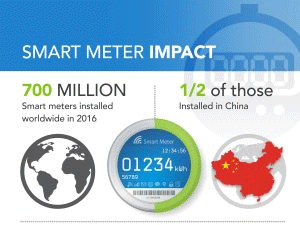Imagine how far we’ve come in the last few years. At first we just talked about machine to machine (M2M) applications, then we started talking more broadly about the Internet of Things (IoT). Today, with the number of devices forecasted to be connected to the internet, alternate networks need to be considered to anticipate how we can manage and track all the new assets that will be interconnected.
High data rate networks like 3G or 4G not required
Ultra-low-power and low data rate applications make up one domain that is particularly well suited for this discussion. For example, devices that address the smart meter domain, building or home control as well as asset tracking and monitoring do not need to run over traditional high data rate telecommunications networks such as 3G or 4G. There are a number of good reasons to seek alternative solutions reaching from cost per connection, handling of SIM cards and the simple fact of course that mobile networks are specifically designed for high data rates incurring high power consumption on the end points. The IoT end points we mentioned need to be able to send short bursts of data over long ranges whilst running off batteries for a number of years to ensure more accurate billing, capacity tracking or usage as well as being able to mitigate any potential losses over the grid.
 Countries, especially China, are embracing the adoption of smart meters
Countries, especially China, are embracing the adoption of smart meters
Let’s take a quick look at a few of the numbers that are behind this development – by the end of 2016 there were an estimated 700 million smart meters installed worldwide. Of these, half of them are in China. In Europe, new EU standards are driving massive adoption – signaling a battle for installation and deployment with utility providers. Being able to roll out the deployment of the sheer number of meters needed within the guidelines established will be challenging at best. According to EC Europa, figures for the European Union show that there are aims to replace 80% of electricity meters with smart meters by 2020, or 200 million smart meters for electricity.
What does this mean for users? This means that there are objectives that have been established to accelerate the uptake of smart metering, in part due to the continued requirements for reducing environmental pollution; in part because the utility companies require the additional flexibility to better manage their energy resources and ensure a fluid and sustained delivery to all users simultaneously. Also, with the increased adoption of renewable energy such as solar or wind energy many households have become energy producers over the past few years instead of being consumers only, so the grid needs to communicate in two ways now.
Alternative sub GHz RF networks cut through the noise of crowded urban networks
Typically, these types of applications could be moved to alternative networks that use sub GHz RF technology. Sub GHz can cover a wide range of frequency bands, with higher sensitivity and blocking performance giving it better coverage in congested areas. As a bonus there is even dedicated spectrum designated for metering only, avoiding cross talk with other applications. This means that the RF range, performance and power levels can be more easily controlled. This makes them more robust since they are more efficient and the larger range can extend to a a few kilometers compared to tens of meters of systems using higher frequency bands. The other advantage is that this means that the network can expand more easily to scale up in anticipation of the volume of new devices that will be connected over the coming years. Finally, the lower power packet means that the devices that are connected via this network are operational for far longer – this can be as much as up to ten years on a coin-cell battery. This is particularly important for many of the devices that will be operating here that could often be in highly inaccessible places to replace a battery frequently.
Sigfox and NXP provide industry with low-power device-to-cloud smart metering solution that works around the world
NXP’s multi-standard RF Sub-GHz transceiver platform offers a turnkey solution that provides flexibility and scalability for these types of integrated solutions for low-power IoT applications. The resource rich platform offers rapid integration and supports different functionalities through its modular approach. In partnership with Sigfox – a world leading provider of connectivity for the Internet of Things (IoT) with a unique approach to device-to-cloud connectivity – the three greatest barriers to global adoption can be addressed. Cost, energy consumption and global scalability are the key challenges for the large-scale deployment of smart metering applications.
Sigfox has built a global network to listen to billions of devices broadcasting data. This network can pick-up very small signals sent by IoT devices using the lowest amount of energy. Because of this network, the lack of standardization is overcome and the same end-to-end solution is used across different geographies. The consequences of this are fairly evident from a cost perspective – not only can economies of scale be applied, but also there is a clear reduction in infrastructure maintenance since devices can be deployed with cloud connectivity.
Sigfox’s extremely low power technology is therefore well adapted to the long lifetime cycle of meters and can be easily mixed with other wireless or wired technology. This means that there can be a smooth transition between existing installations and new technology offerings – making it easier for the utility companies to deploy the new meters and easier for customers to start using them.







